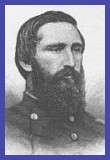In 1863 Philadelphia was a small market town six miles south of a railroad bridge on the Tennessee River that had become a hotly contested prize of war. The rolling green hills around Philadelphia were prime agricultural land, whose main products were corn, wheat and hogs, though quantities decreased drastically as the war progressed. The residents were divided between Confederate and Union sympathizers, but with the secession of Tennessee from the Union in June 1861, the former faction gained the upper hand. Many Union men left the region to serve with locally raised Federal regiments, while many of their brothers, cousins or former classmates joined either the Confederate army or the guerrilla bands that flourished in the area. Philadelphia, however, was largely untouched by the war until the invasion of East Tennessee by Federal forces under Major-General Ambrose Burnside in the summer of 1863. In late August, the 45th joined the brigade of Colonel Robert K. Byrd, which included the 1st East Tennessee Mounted Volunteer Infantry, 112th Illinois Mounted Infantry and 8th Michigan Cavalry, and was ferried across the Tennessee River, near Loudon, in advance of the rest of the brigade. The regiment took up positions on the south bank together with the 118th Ohio Volunteer Infantry and the 24th Indiana Battery. With the Federals pouring into the area, the hard-pressed Confederates decided to destroy the bridge they had fought so hard to protect. On September 2, after rebel troops and sympathizers had passed safely across, the rear guard, under the command of Lieutenant William G. Allen, set fire to the bridge and made its escape. In the confusion of the retreat, however, the Confederates neglected to destroy materials for a pontoon bridge that had been stored not far upstream. Using these materials, The victorious Federals quickly began building a bridge for moving the bulk of their forces south across the Tennessee. The 45th did not have a long respite -- on September 5 a party of twelve men from Company D, under Lieutenant William L. Williams, was attacked two miles outside Philadelphia while escorting a herd of twenty cattle to camp. The Confederate troops, nearly 100 strong, captured ten members of the party, with only Williams and one other man making their escape. |

The 45th at Philadelphia The Battle of Philadelphia, on October 20, 1863, may not have been one of the most famous of the Civil War, or even of the war in East Tennessee, yet it resulted the more losses for the 45th OVI -- four men killed, nine wounded and 134 captured -- than any of the nearly 50 engagements in which the regiment participated in its three years of service. Of the 134 captured 83 later died in rebel prisons. These losses occurred in the course of a hard-fought battle that turned into a rout for the Federal side, namely the 1st Kentucky Cavalry, 11th Kentucky Cavalry, 24th Indiana Light Artillery and the 45th -- then known as the 45th Ohio Mounted Infantry. Members of a brigade commanded by Colonel Frank Wolford, these units lost a total of 479 men, of which seven were killed, 25 wounded and 447 captured. The Union forces also suffered large material losses, including six mountain howitzers, all of their wagons and most of their ammunition and other supplies. |
What caused this disaster? In Wild Riders of the First Kentucky Cavalry, a regimental history published in 1894 and reprinted by Genesis Publishing in 1997, author Eastman Tarrant states flatly that the defeat at Philadelphia "has always been attributed to treachery" (304) with the Confederates violating a flag of truce to the secure the surprise that led to their victory. The Confederate side, however, claimed military necessity. In a letter to Jefferson Davis sent on October 23, 1863, three days after the battle, General John C. Vaughn, the commander of the Confederate forces at Philadelphia, said that he decided to disregard the flag because otherwise one of his brigades, commanded by Colonel J.J. Morrison, "would be all cut to pieces and captured" (ibid, 305) by Wolford's troops. |
Wolford, meanwhile, made miscalculations that sealed his fate, most notably the dispatch of 600 men -- nearly half his force -- to rescue a forage train just prior the Confederate attack. Nonetheless, the truce flag incident gave the Confederates an advantage they exploited to the fullest, leading to a signal victory, if not a decisive one. After the battle the Federal forces regrouped at nearby Loudon and engaged the enemy in several days of fierce skirmishing. On the 28th of October they withdrew in good order to Knoxville, arriving the next day. A portion of the brigade stayed there to be refitted, while the remaining effectives went into camp at nearby Maryville. In the following weeks, under Brigadier General William P. Sanders, Wolford's brigade played a key role in the defense of Knoxville, which climaxed on November 29 with the disastrous assault by Confederate troops under Lieutenant General James Longstreet and their withdrawal soon after. |
Colonel Frank Wolford |
Brig. Gen. William P. Sanders |
